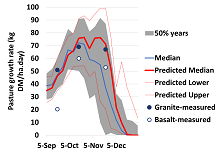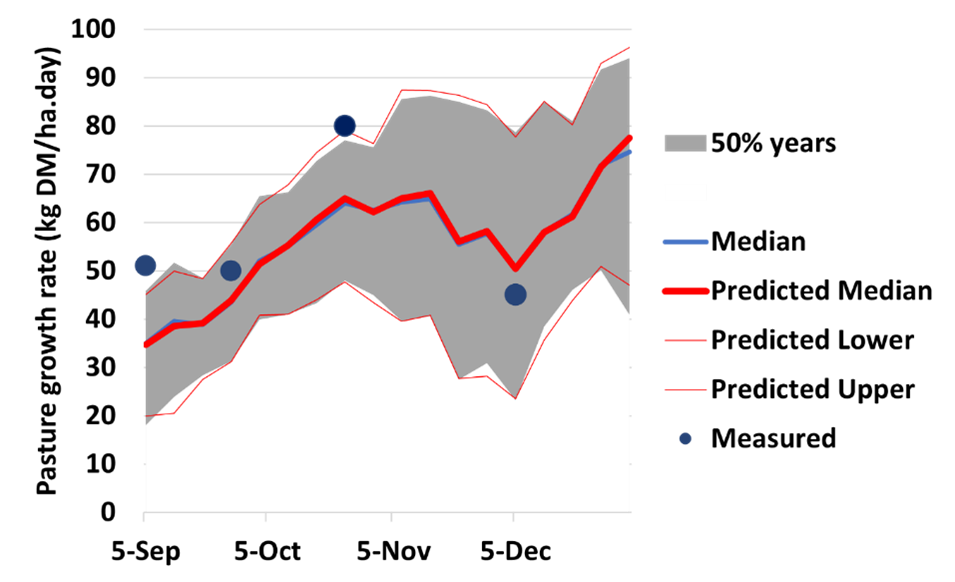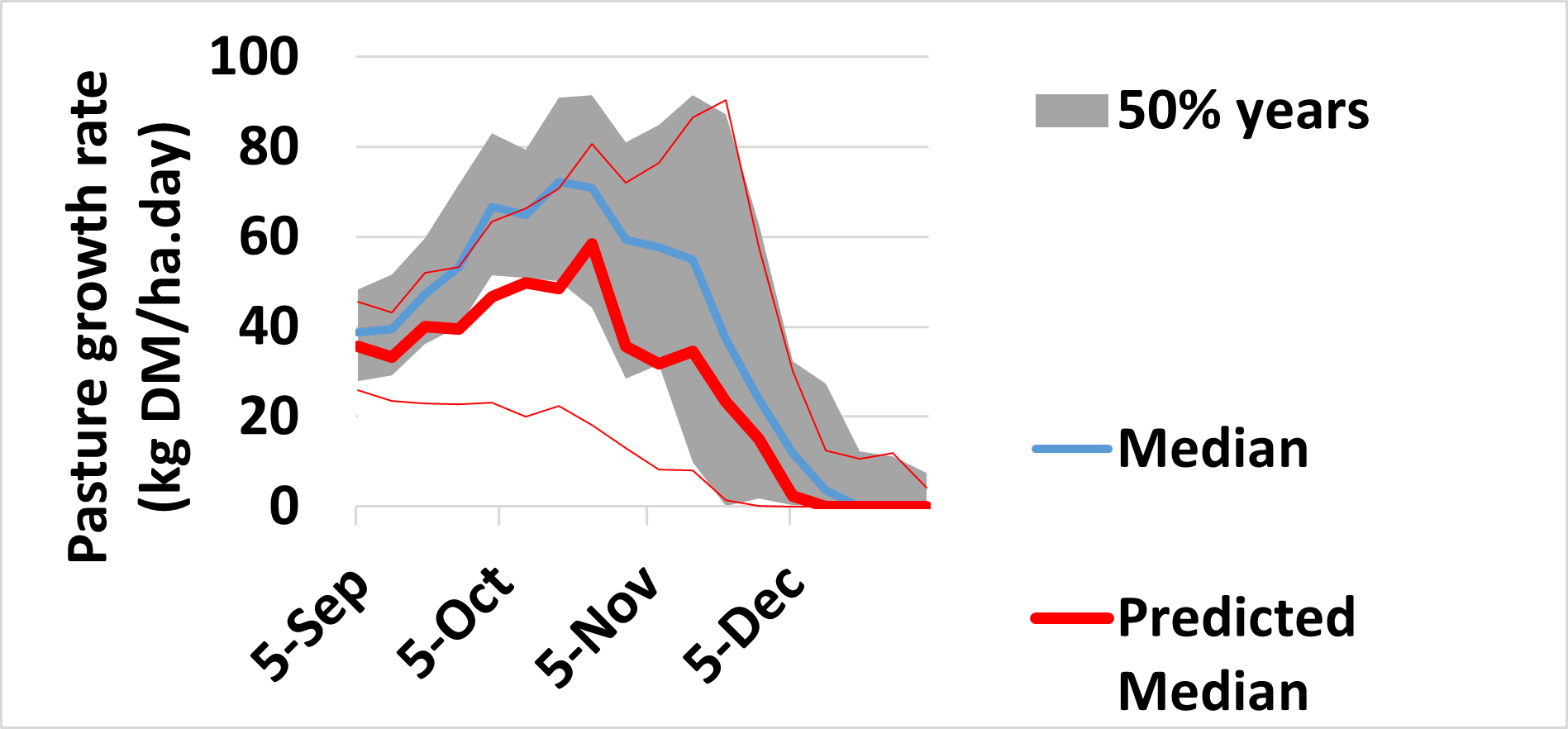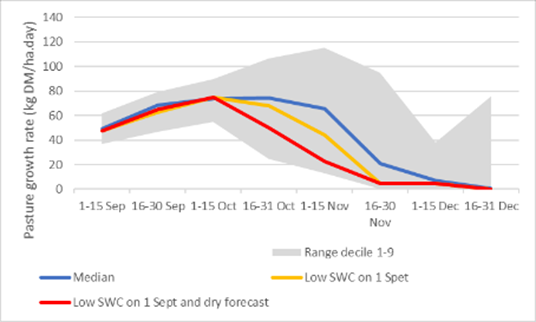Probing early decisions - soil moisture probes – Enhanced Producer Demonstration Site (PDS)
Download a printable version of this page: Predicting spring pasture growth ![]() [PDF File - 402.8 KB]
[PDF File - 402.8 KB]
The seasonal variability of pasture growth has increased across southeast Australia in recent decades. Previous research has indicated that soil water content in early spring can be a good predictor of pasture growth over the following months. Early prediction of spring growth can help farmers make early management decisions, particularly in the event of a poor spring.

The demonstration
This Enhanced Producer Demonstration Site, “Predicting spring pasture growth”, aimed to investigate whether soil moisture at the beginning of spring is a good predictor of spring pasture production. Four paddocks across southwest and central Victoria – all with soil moisture probes - were used as demonstration sites. Pasture cuts were made over the spring period to estimate pasture growth. Seasonal pasture predictions for each site were produced at the beginning of spring, using the Sustainable Grazing Systems (SGS) model, soil moisture at each site and seasonal forecasts. The demonstration was run between 2019 and 2021.
The sites
There were two sites in central Victoria (Baynton) on different soil types and two in southwest Victoria - one at Harrow and one at Dartmoor. These were modelled for pasture predictions in 2019, 2020 and 2021. A site at Coojar was added in 2021. All pastures were based on perennial species. The central Victoria paddocks were phalaris with sub clover and some annual grasses and broadleaf weeds. The Harrow site was also phalaris, but with a good balansa content leading to early growth. The Dartmoor paddock was a mix of lucerne, phalaris and ryegrass - resulting in growth over the summer. The Harrow and Baynton sites were predominantly grazed by sheep (and some cattle) and the Dartmoor site was grazed by cattle and cut for hay and silage over the spring period.
The seasons
For each of the years (2019, 2020 and 2021), soil moisture was full or close to full at the beginning of spring. While the forecast in 2019 was for a drier-than-average year, all sites experienced a good spring season.
The forecasts in 2019 and 2020 were for wetter-than-average springs across the state, and these forecasts were included in the predictive models, along with soil moisture. Hence, average to above-average springs were experienced across all sites in each year. Seasonal forecasts for wetter-than-average springs tended to extend the predicted growing season.
How did we go?
Pasture growth for spring at all sites was within the predicted ranges modelled on 1 September 2019 and 2021, albeit some outliers in 2019 that were explained by grazing management and species composition. Few pasture cuts were made in 2020. All soil profiles were full at the beginning of spring in 2021 and the forecast was for a wetter-than-average spring (between 65–75 per cent depending on where you were in the state). Therefore, all predictions were for above-average growth (in peak and/or length of spring growth), which was what occurred at these sites. Figures 2 and 3 show the predicted and measured growth rates for spring 2021 at Baynton and Dartmoor respectively. The red line shows the predicted spring growth compared to the long-term median growth (blue line) and the upper and lower ranges over fifty per cent of years are shown by the shading. The predicted and average long-term median were similar at the Dartmoor site because of the higher reliability of winter/spring rainfall at this site.


What if it had been dry?
As the project did not experience a dry start over the three years, we looked at what the predictions would have been, given a low soil moisture at the start of spring (based on the soil moisture on 1 September in 1982 or 2006).
At Baynton, using the granite soil type, if soil moisture was historically low on 1 September, then lower growth and a shorter growing season was predicted (Figure 4). With no seasonal rainfall predictions included, the dry start was estimated as a loss of 1,450 kg DM/ha over the period from 1 September to 31 December, and a shorter season. Similarly, at Harrow the loss in production (with average rainfall but low starting moisture) was estimated at 1750 kg DM/ha (Figure 5).


At Dartmoor, the rainfall is more reliable.Even with a starting point as estimated for September in 1982, the predictions for the season were close to average with a slight drop off at the end of summer.
At the Coojar site, the effect of historically low soil water content on spring pasture growth was simulated using the soil water content on 1 September 2006, when the soil profile was approximately half-full.The effect of historically low soil water content on 1 September on the predicted median spring pasture growth rates showed a contraction of the growing season by about two weeks compared with the long-term median (Figure 6).
When low soil water content on 1 September is combined with a seasonal forecast predicting 70 per cent chance of below median rainfall, there is a further contraction of the median predicted growth rate by about two weeks (Figure 6).

Magic spring day
As moisture was not generally limiting at any sites in the lead up to spring, but low soil temperatures over winter was at some sites, we looked at when temperature (air temperature as the main limitation to photosynthesis) would reach optimal for pasture growth. The SGS model came up with the following dates for when close to maximum (80%) photosynthesis was achieved, using climate data from 1990-2019 (Table 1). These dates are comparable to the sharp increases on the spring pasture growth curves at each site, and the non-limiting date (at 90%) as close to the peak (0.9 on = 15°C average daytime temp). To reach the 0.9 level, it was estimated to occur three to four weeks later.
Table 1 Estimated dates for reaching maximum photosynthesis 0.8 (80%) and 0.9
0.8 | 0.9 15oC | |
|---|---|---|
Violet Town | 29 Aug | 22 Sep |
Baynton | 27 Sep | 15 Oct |
Pigeon Ponds | 3 Sep | 27 Sep |
Coojar | 3 Sep | 2 Oct |
Dartmoor | 5 sep | 22 Sep |
Using soil probe information for making decisions
Feedback from farmers involved in the demonstrations indicated that most had confidence in the spring predictions to consider making decisions based on soil moisture in late winter/early spring in the future. Knowledge of a drier soil profile in August could assist with key management decisions such as selling stock early (or purchasing), buying-in feed and decisions on pasture sowing. At the more reliable rainfall site (Dartmoor), soil moisture later in the spring/summer period was considered most useful in making decisions regarding pasture sowing, such as summer crops.
A summary of the early decisions identified included:
- Farmers in the less reliable areas indicated that looking at moisture in August would trigger decision options for selling stock early/buying in feed.
- Buy or sell stock early – avoid stock price drops (as in 2002 and 2006) and reduce the numbers of stock to feed and water.
- Buy feed early – avoid price hikes (e.g., $200/t for hay in 2002 and 2006 and approximately $35/t in 2016 and grain increases of over $150/t in 2002 and 2006), but also accessing/assuring supply and quality.
- Pasture ‘boosting’ decisions in autumn/winter using soil moisture and temperature, to use additives like urea and/or gibberellic acid.
- Soil temperature in pasture is an important limitation to pasture growth in some areas.
- In the area with higher occurrence of good soil moisture in August/September the group identified the value of soil temperature and moisture for making pasture sowing decisions, especially late in the season.
- Pasture sowing decisions in autumn (before too cold) or spring (before moisture limiting) and for summer crops e.g., brassicas.
- Potential for runoff was also identified.
The following section on soil temperature for pasture sowing was put together for a webinar and SheepNotes newsletter by Laura Forward (formerly Meridian Agriculture), as part of the project.
Using soil temperature to make sowing decisions
Laura Forward, Meridian Agriculture
When preparing to sow pasture paddocks, either in autumn or spring, the main consideration is usually moisture. In autumn, it’s all systems go as soon as we get some decent rainfall, while in spring it’s often a question of how soon we can get on the paddock without getting the tractor bogged. The other key consideration is soil temperature, which is frequently missed despite it playing a huge role in whether or not your sowing is successful.
In the autumn, we are generally considering the temperature requirements of temperate grasses (ryegrass, phalaris, etc.) and legumes (clovers and sometimes lucerne). The optimal topsoil temperature ranges for these species are listed in Table 2.
In spring, we are most often considering summer crop species such as brassicas/forage rape, maize, millet or sorghum. The temperature requirements for these species are listed in Table 3. If spring sowing phalaris – a fairly common practice – the temperature guidelines for grasses in Table 2 will apply.
Table 2 Top-soil temperature requirements for autumn-sown species
Most grasses | Legumes | |
|---|---|---|
Above 10° | 4 | 4 |
Between 5° and 10° | 7 | Some will strike, but will be slow and lack vigour |
Below 5° | 7 | 7 (1) |
Table 3 Top-soil temperature requirements for spring-sown species
Brassica | Maize | Millet | Sorghum | |
|---|---|---|---|---|
Below 8° | Will begin to strike, but slow and not ideal | 7 | 7 | 7 |
Between 8° and 12° | 4 | Will strike, but will be slow | 7 | 7 |
Between 12° and 15° | 4 | 4 (2) | 7 | 7 |
Between 15° and 18° | 4 | 4 | Ideal is 15° and rising | 7 |
Above 18° | 4 | 4 | 4 | 4 (2) |
The Agriculture Victoria soil moisture probe network provides real time soil and moisture data for many soil probe sites across the state. Looking at historical soil temperature (with approximately three years of data available for most pasture sites) is useful to see when critical temperatures generally occur and can be used as a guide as to when plants may need to be established.
References
Jim Moir. (2020) Advances in Plant Sciences. New Zealand Journal of Agricultural Research 63:3, pages 269–271.
Serafin, L., 2022. Moving summer crop sowing early or late - risks and rewards on the Liverpool Plains. Grains Research and Development Corporation. Accessed February 2023
Key messages
- Soil moisture and seasonal forecasts were good predictors of spring pasture growth in the good years experienced over the project
- Soil moisture has the potential to act as an ‘early warning signal’ in dry springs, when management decisions may reduce the impact if made early
- A full soil moisture profile at the beginning of spring will give a prediction of at least an average spring, unless a dry spring is forecast
- August or late winter/spring was identified as a key time to use soil moisture probe data for early decisions on stocking; feed budgeting and fodder purchases, in the less reliable rainfall sites
- Colder sites also identified that soil temperature can be as critical as moisture in helping to make critical decisions on pasture boosting and/or sowing
- In the more reliable rainfall site, soil moisture and temperature were identified to be of most use late in the season for summer for other pasture sowing decisions (e.g. summer crops)
- Both current soil moisture and temperature as well as historic trends can be useful in making pasture sowing decisions. Looking at historical soil temperature (about three years of data is available for most pasture sites) is useful to see when critical temperatures generally occur and can be used as a guide as to when plants may need to be established.
The Agriculture Victoria soil moisture probe network provides real time soil and moisture data for many soil probe sites across the state and is available at extensionaus.com.au/soilmoisturemonitoring/.
More information
Jane Court, Agriculture Victoria – Bendigo
M: 0436 606 742
E: jane.court@agriculture.vic.gov.au
Acknowledgements
The authors acknowledge the soil probe site hosts and groups associated with this project (Hawkesdale BetterBeef group; Glenelg BestwoolBestlamb group and the Central Ranges Grassland Society of Southern Australia branch).
Authors
Jane Court (Agriculture Victoria) and Brendan Cullen (University of Melbourne), August 2022